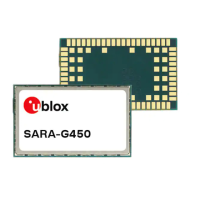SARA-G450 - System integration manual
UBX-18046432 - R08 Design-in Page 78 of 143
C1-Public
To achieve a 50 characteristic impedance, the width of the transmission line must be chosen
depending on:
the thickness of the transmission line itself (e.g. 35 µm in the example of Figure 38 and Figure 39)
the thickness of the dielectric material between the top layer (where the transmission line is
routed) and the inner closer layer implementing the ground plane (e.g. 270 µm in Figure 38, 1510 µm
in Figure 39)
the dielectric constant of the dielectric material (e.g. dielectric constant of the FR-4 dielectric
material in Figure 38 and Figure 39)
the gap from the transmission line to the adjacent ground plane on the same layer of the
transmission line (e.g. 500 µm in Figure 38, 400 µm in Figure 39)
If the distance between the transmission line and the adjacent ground area (on the same layer) does
not exceed 5 times the track width of the micro strip, use the “Coplanar Waveguide” model for the
50 calculation.
Additionally to the 50 impedance, the following guidelines are recommended for the transmission
line design:
Minimize the transmission line length: the insertion loss should be minimized as much as possible,
in the order of a few tenths of a dB.
Add ground keep-out (i.e. clearance, a void area) on buried metal layers below any pad of
component present on the RF transmission line, if top-layer to buried layer dielectric thickness is
below 200 µm, to reduce parasitic capacitance to ground.
The transmission line width and spacing to ground must be uniform and routed as smoothly as
possible: avoid abrupt changes of width and spacing to ground.
Add ground vias around transmission line, as described in Figure 40.
Ensure a solid metal connection of the adjacent metal layer on the PCB stack-up to main ground
layer, providing enough on the adjacent metal layer, as described in Figure 40.
Route RF transmission line far from any noise source (as switching supplies and digital lines) and
from any sensitive circuit (as analog audio lines).
Avoid stubs on the transmission line.
Avoid signal routing in parallel to transmission line or crossing the transmission line on a buried
metal layer.
Do not route a microstrip line below a discrete component or other mechanics placed on the top
layer.
Two examples of correct RF circuit design are illustrated in Figure 40, where the antenna detection
circuit is not implemented (if the antenna detection function is required by the application, follow the
guidelines for circuit and layout implementation detailed in section 2.4.2):
In the first example described on the left, the ANT pin is directly connected to an SMA connector
by means of a suitable 50 transmission line, designed with an appropriate layout.
In the second example described on the right, the ANT pin is connected to an SMA connector by
means of a suitable 50 transmission line, designed with an appropriate layout, with an additional
high pass filter (consisting of a suitable series capacitor and shunt inductor) to improve the ESD
immunity at the antenna port of SARA-G450 modules, if needed.

